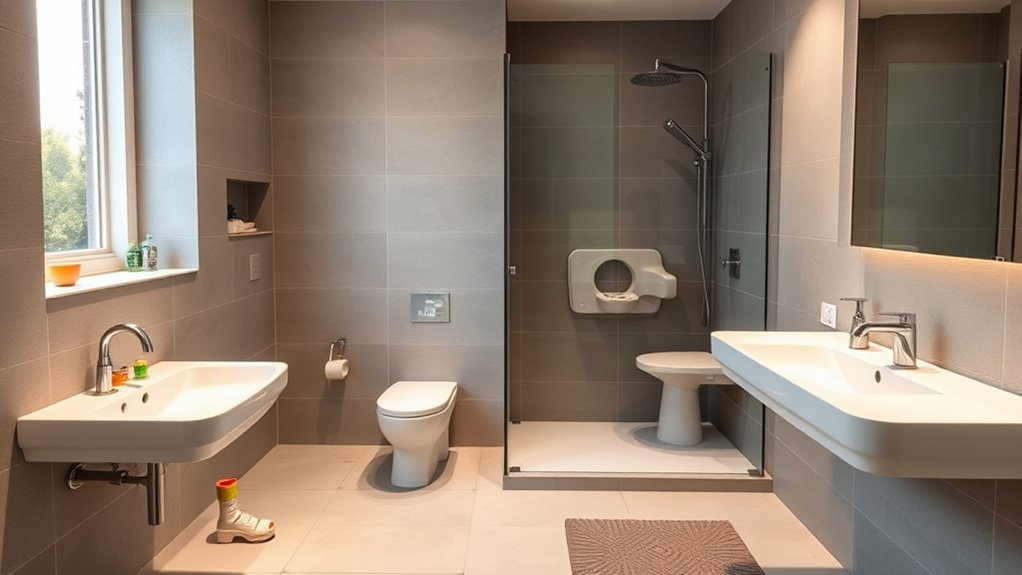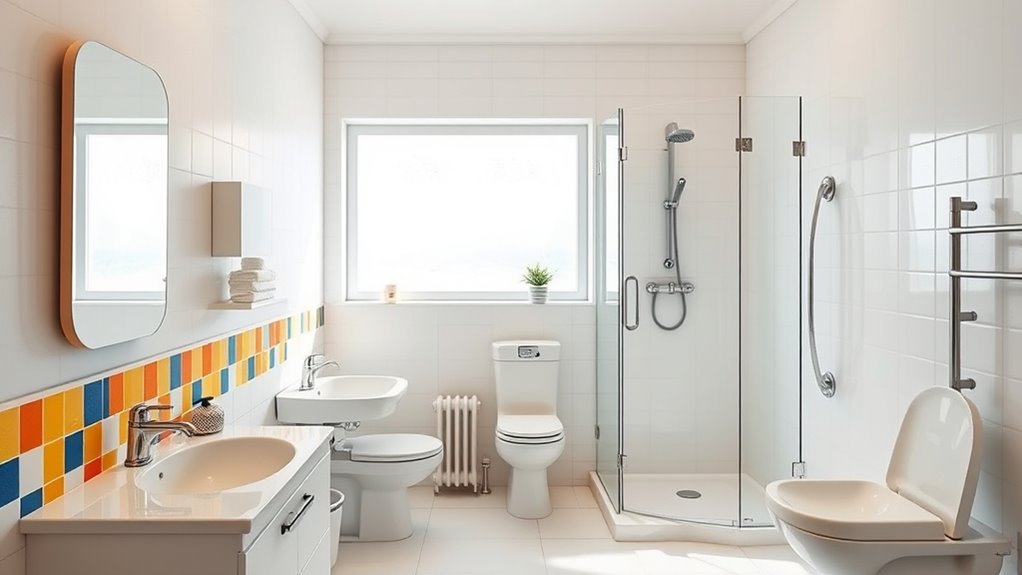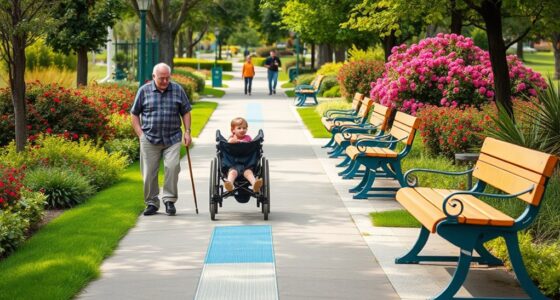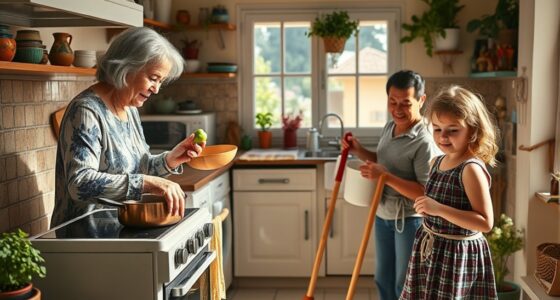When designing bathrooms for all ages, focus on safety, accessibility, and functionality. Use non-slip mats, rounded edges, and secure cabinets to prevent accidents for kids. Incorporate fixtures suitable for different heights and add grab bars for elders. Install GFCI outlets to protect everyone from electrical hazards. By considering each age group’s needs and safety features, you create a space that’s secure and comfortable for everyone. Keep exploring to learn more tips for a truly inclusive bathroom.
Key Takeaways
- Incorporate non-slip mats and textured surfaces to prevent slips for all age groups.
- Use rounded edges and safety latches to minimize injury risks for children and elders.
- Install grab bars and adjustable fixtures to enhance accessibility and support mobility.
- Ensure electrical outlets are GFCI-protected and placed safely away from moisture zones.
- Design flexible layouts that accommodate varying heights and physical capabilities for everyone.

Have you ever considered how a well-designed bathroom can serve everyone in your family, regardless of age? When you think about creating a space that’s safe and functional for kids, adults, and elders alike, it’s essential to prioritize features that accommodate their unique needs. Child safety should be at the top of your list, ensuring your little ones are protected from slips, falls, and other hazards. Installing non-slip mats in the shower and on the bathroom floor can prevent accidents, especially since kids tend to move quickly and might not always be aware of wet surfaces. Rounded edges on counters and fixtures also reduce the risk of injuries if a child bumps into them. Additionally, securing cabinets and shelves out of reach keeps small hands from grabbing potentially dangerous items like cleaning supplies or razors. Using safety latches on cabinets further enhances child safety by preventing accidental access to harmful products. Recognizing that bathroom design plays a crucial role in maintaining safety can help you stay focused on creating a secure environment for everyone. Incorporating electric safety features such as ground-fault circuit interrupters (GFCIs) is also vital to prevent electrical hazards caused by moisture in the bathroom.
Frequently Asked Questions
How Can I Incorporate Safety Features Without Compromising Style?
To incorporate safety features without compromising style, focus on blending child safety elements seamlessly into your design. Use sleek, non-slip flooring and rounded edges that look modern yet protect little ones. Install discreet grab bars and height-adjustable fixtures that maintain aesthetic balance. Choose stylish, functional accessories that enhance safety without cluttering the space. This way, you create a bathroom that’s both beautiful and secure for everyone.
What Are the Best Materials for Slip-Resistant Bathroom Flooring?
They say a stitch in time saves nine, so choosing the right flooring is key. For slip-resistant bathroom floors, opt for non-slip tiles or textured flooring that provide grip even when wet. These materials help prevent falls without sacrificing style, making your bathroom safer for everyone. Look for options with matte finishes or textured surfaces, ensuring durability and safety while maintaining a sleek look.
How Do I Maximize Space in Small, Multi-Age Bathrooms?
To maximize space in small, multi-age bathrooms, you should focus on compact storage solutions like wall-mounted shelves and over-the-toilet units. Opt for creative layouts, such as corner sinks or sliding doors, to free up floor space. Use vertical space efficiently and choose multipurpose fixtures to keep the area organized and functional for all ages. These strategies help create a more spacious, accessible bathroom tailored to everyone’s needs.
What Lighting Options Are Suitable for All Age Groups?
Imagine your bathroom as a stage where every age group takes the spotlight. To keep the show running smoothly, choose adaptable illumination that adjusts with a tap or voice command, offering bright, age-appropriate lighting for kids, adults, and elders alike. Incorporate layered fixtures like dimmable LEDs or task lights, ensuring everyone feels comfortable and safe. This flexible lighting setup makes your bathroom a welcoming, versatile space for all.
How Can I Future-Proof a Bathroom for Evolving Needs?
To future-proof your bathroom, you should focus on universal design principles and adaptive fixtures. Incorporate features like adjustable-height sinks and grab bars that can be easily modified as needs evolve. Use flexible layouts that accommodate mobility aids and ensure good lighting for visibility. By planning with adaptability in mind, you’ll create a space that remains functional and comfortable for everyone, regardless of age or ability.
Conclusion
Creating a bathroom that serves all ages is like building a sturdy bridge—every detail must support each step, from kid’s tiny hands to elder’s steadying grip. When you thoughtfully incorporate adjustable fixtures and safety features, you craft a space that feels like a safe harbor for everyone. Just like a well-designed bridge stands strong through storms, your inclusive bathroom becomes a haven where all ages feel secure and comfortable, making everyday routines smoother for everyone.









